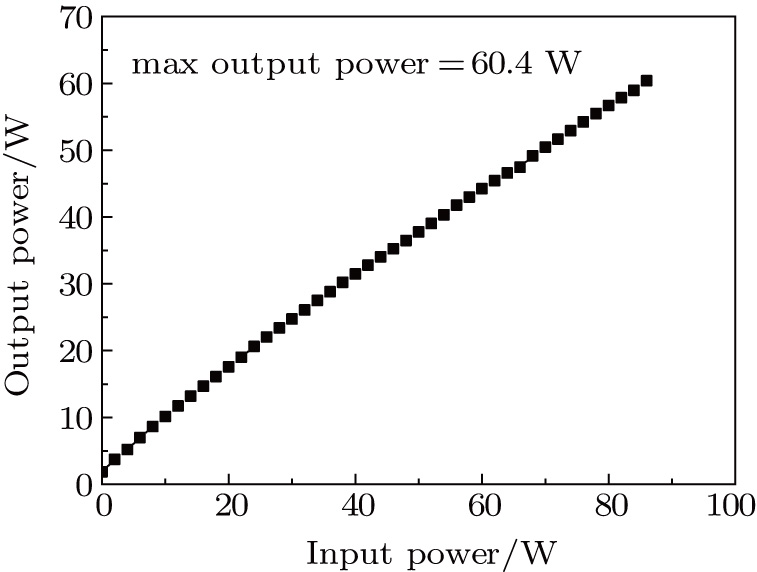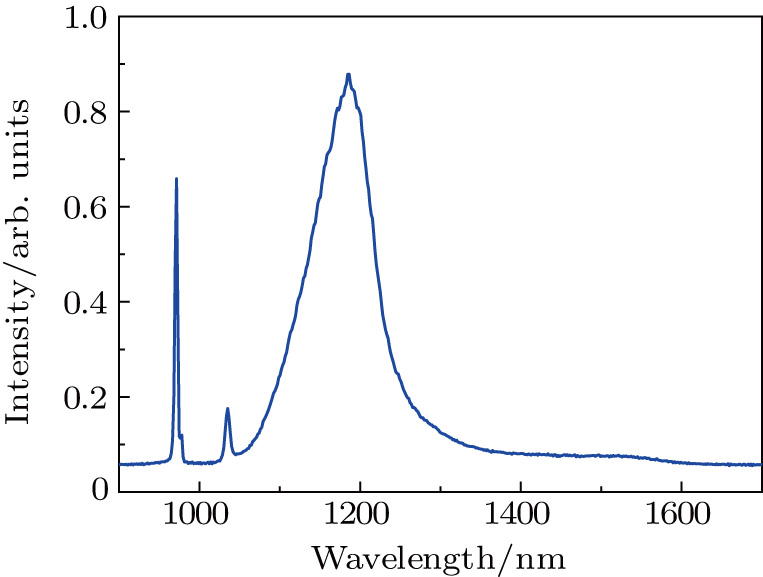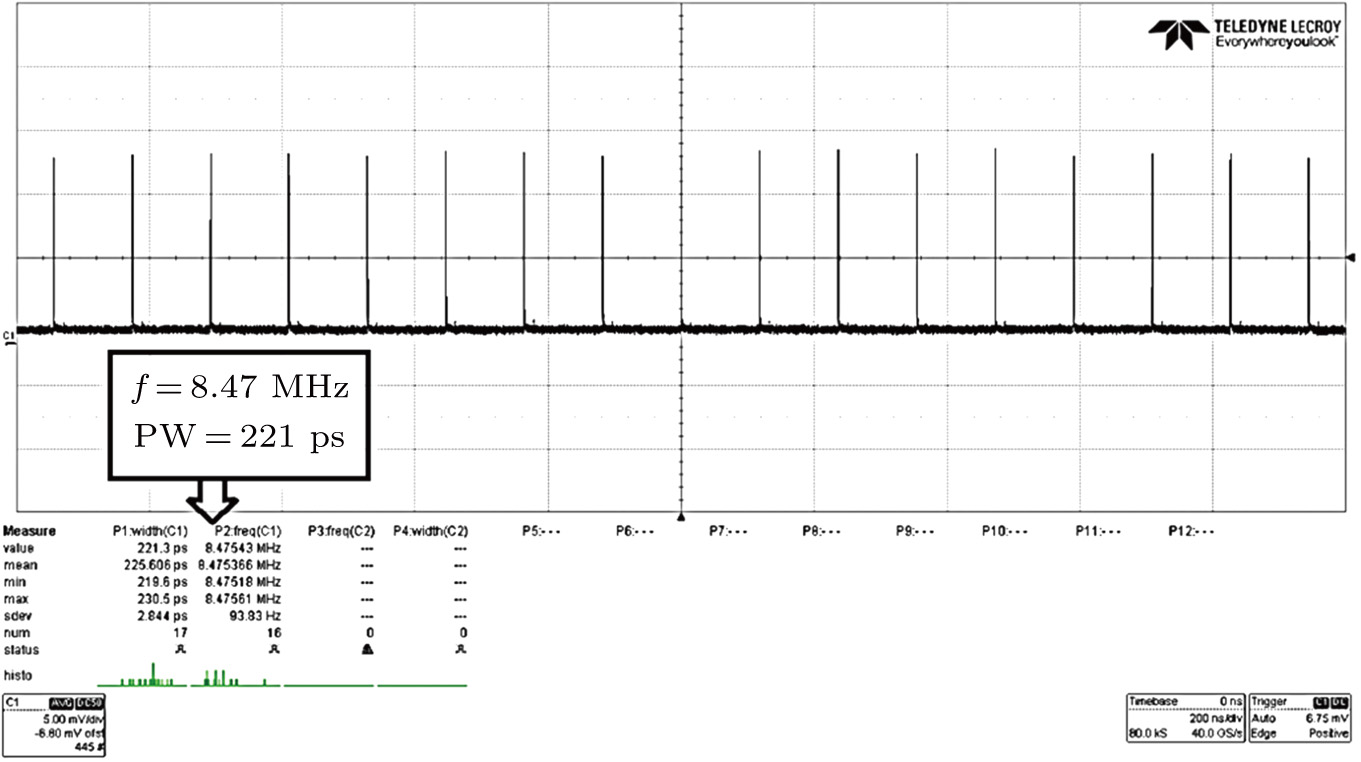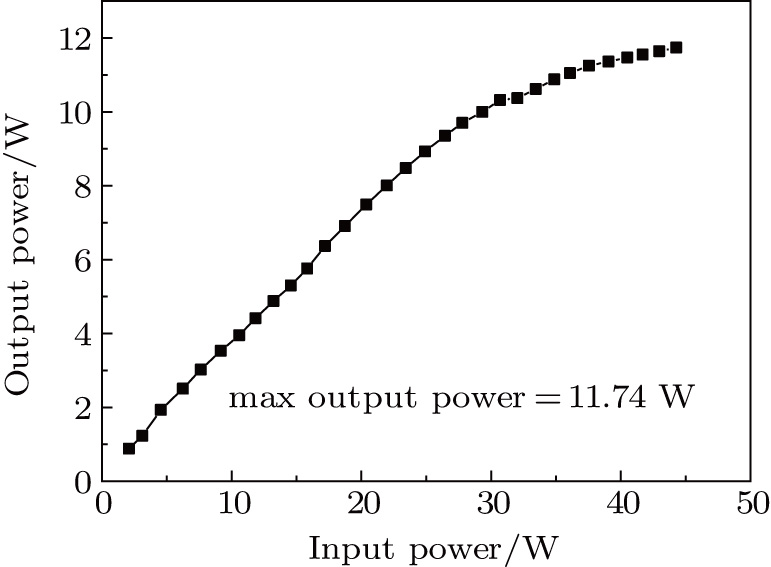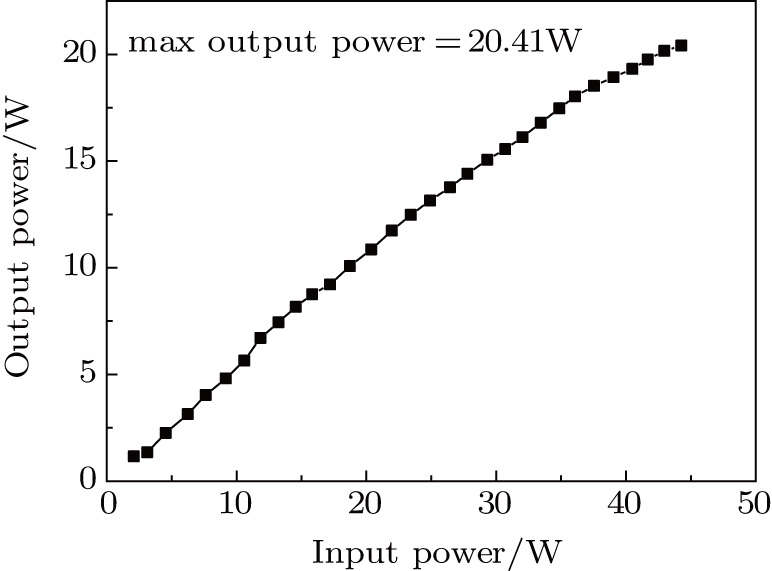† Corresponding author. E-mail:
We report a supercontinuum source generated in seven-core photonic crystal fibers (PCFs) pumped by a self-made all-fiber picosecond pulsed broadband fiber amplifier. The amplifier’s output average power is 60 W at 1150 nm with spectral width of 260 nm, and its repetition rate is 8.47 MHz with pulse width of 221 ps. With two different lengths of seven-core PCF, different output powers and spectra are obtained. When a 10 m long seven-core PCF is chosen, the output supercontinuum covers the wavelength range from 620 nm to 1700 nm, with the output power of 11.7 W. With only 2 m long seven-core PCF used in the same experiment, the wavelength of the supercontinuum spans from 680 nm to 1700 nm, with the output power of 20.4 W. The results show that the pulse width is 385 ps in the 10 m long seven-core PCF and 255 ps in the 2 m long one, respectively, due to the normal dispersion of the PCF.
Recently, the supercontinuum source has played an important role in a wide area, such as spectroscopy,[1] multi-wavelength pulse source,[2] frequency metrology,[3] and so on. Good results are obtained by different kinds of fiber lasers: continuous lasers,[4,5] nanosecond pulse lasers,[6,7] and picosecond/femtosecond pulse lasers.[8–11] Some of them have reached hectowatt scale.[4,8,9] Compared with continuous laser, picosecond/femtosecond pulsed laser has more advantages because it has much higher peak power to induce stronger nonlinear effects for wider spectrum. However, the nonlinear effects resulting from the femtosecond pulsed laser are always too strong to keep the pulse trains stable. Besides this, the output pulses are mired in a mess caused by the soliton self-frequency shift and modulation instability.[12] They have serious distortion even breaking into lots of small pulses. Picosecond pulsed laser has not only high single pulse energy and peak power, but also high nonlinear effects mainly of self-phase modulation (SPM) and stimulated Raman scattering (SRS). The output supercontinuum source has orderly pulsed trains with good time coherence and wide flat spectrum simultaneously. These features are beneficial for practical applications, such as photo detection[13] and military interference.[14] Recently, there has been plenty of specific research in supercontinuum pumped by picosecond pulsed laser generated in single-core photonic crystal fibers (PCFs)[15,16] and multi-core PCFs.[17,18] Chi et al.[19] used a 100 W picosecond laser source to pump two different kinds of single-core nonlinear PCF to produce a supercontinuum source and obtained 30 W and 36 W output powers corresponding to spectral broadening ranges from 550 nm to 1650 nm and from 500 nm to 1650 nm, respectively. Single-core nonlinear PCF has thin core and strong nonlinear effects, but its mode field diameter is small and the welding efficiency is very low due to the mode field mismatch between single-core nonlinear PCF and laser source. In order to solve these problems of mode field mismatch and low coupling efficiency, multi-core PCF is generally applied. It also assures strong nonlinear effects to bring out high power supercontinuum at the same time. Modotto et al.[20] reported supercontinuum of mW scale generation in a multi-core PCF pumped by a 600 ps Q-switched germanium-doped Nd:YAG pump laser. But space coupling system is unstable and the input face of the PCF is easily damaged by laser. Therefore an all-fiber system is more favorable for supercontinuum. Wei et al.[21] investigated a supercontinuum source produced in 20 m seven-core PCF pumped by a 20 ps fiber amplifier at the repetition rate of 480 MHz. The generated supercontinuum covers the wavelength range from 720 nm to beyond 1700 nm, with an output power of 42.3 W. Huang et al.[22] demonstrated a gain-switched all polarization-maintaining fiber laser system with pulse width of 160 ps and average output power of 4.5 W utilized to pump 35 m seven-core PCF, allowing the supercontinuum source with output power of 2.443 W covering wavelength from 500 nm to 1700 nm. Chen et al.[23] reported a 104.2 W supercontinuum spanning from 750 nm to beyond 1700 nm generated from a 20 m long seven-core PCF pumped by a 141.6 W picosecond fiber laser. The high output power embodies the superiorities of the multi-core PCF for the supercontinuum. But the supercontinuum spectrum is not wide enough especially in the short wavelength region because of the high repetition rate of 1.9 GHz of the pump laser which caused low single pulse energy of 5.5 nJ and low peak power of 421 W.
To solve these problems, shorter length of seven-core PCF pumped by a picosecond broadband fiber amplifier with wide spectral width of 260 nm, narrow pulse width of 221 ps, high peak power of 32 kW, and high single pulse energy of 7.08 μJ was adopted to get wider supercontinuum. When a 10 m long seven-core PCF was chosen in the experiment, the output power of the supercontinuum was 11.7 W with wavelength range from 620 nm to 1700 nm. In order to enhance the output power, the length of the seven-core PCF was reduced to only 2 m. When a 2 m long seven-core PCF was used, the output power increased to 20.4 W with the wavelength range from 680 nm to 1700 nm. The pulse trains were very stable, simultaneously. We also analyzed the theory of the broad spectra with the influences of nonlinear effects such as the SPM and the SRS.
As shown in Fig.
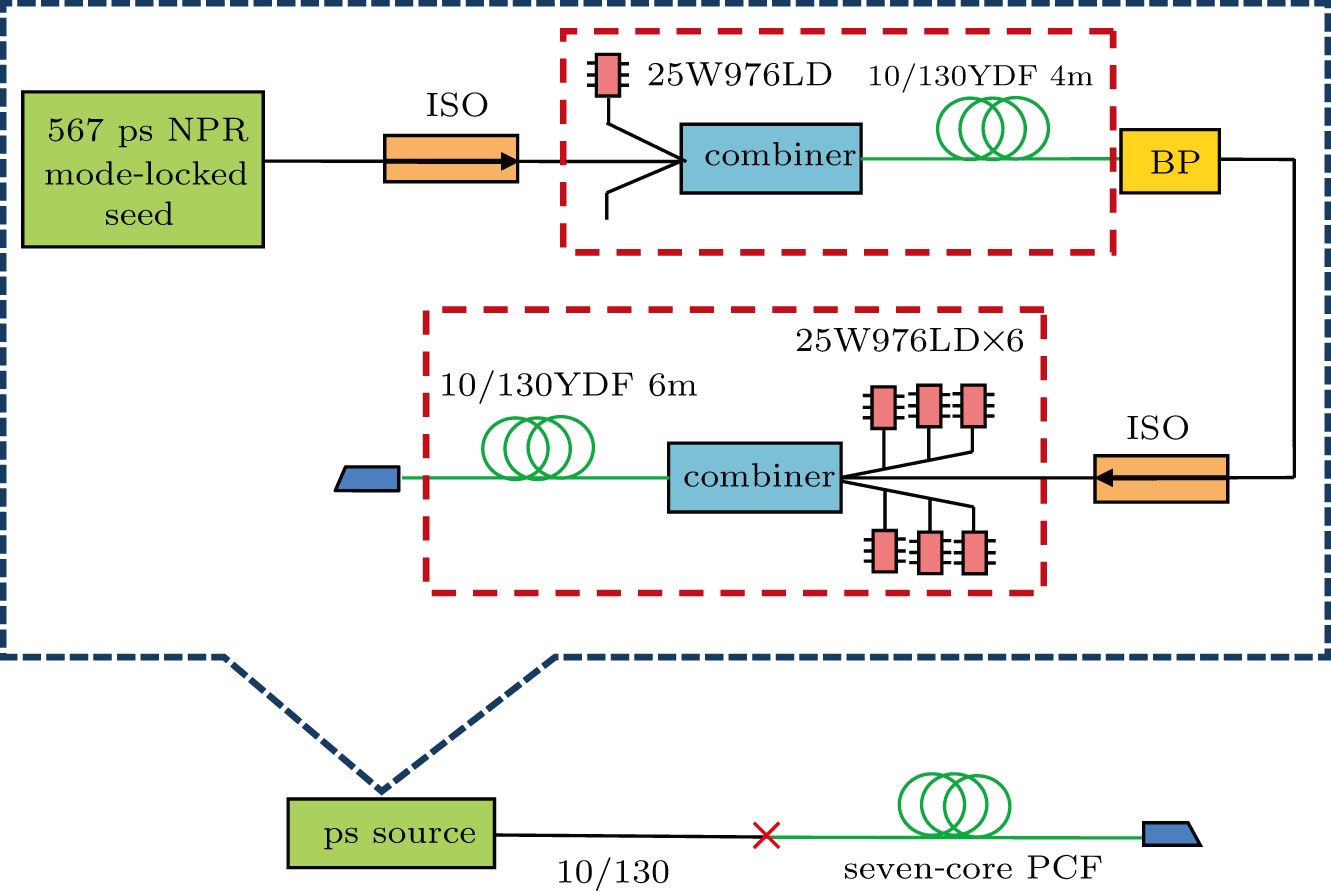 | Fig. 1. (color online) The setup of all-fiber picosecond pulse amplifier and supercontinuum source system. |
When the average pump power of the master amplifier is 86 W, the output power of the amplifier is 60 W, as shown in Fig.
Firstly, we choose a 10 m long seven-core PCF in our supercontinuum experiment. When the output power of the amplifier is 44.3 W, the output power of the supercontinuum is 11.7 W as shown in Fig.
 | Fig. 6. (color online) The output spectrum of the supercontinuum produced in 10 m long seven-core PCF. |
 | Fig. 7. (color online) The laser pulse trains and the pulse width of supercontinuum produced in 10 m long seven-core PCF. |
The supercontinuum generated in the 10 m long seven-core PCF has very wide spectrum and quite high peak power but high average power. So in order to obtain high average output power, high single pulse energy, and wide spectrum simultaneously, the length of the seven-core PCF is cut down to 2 m. The result of the 2 m long seven-core PCF indicates that the output power rises to 20.4 W with the same injection power of 44.3 W, just as shown in Fig.
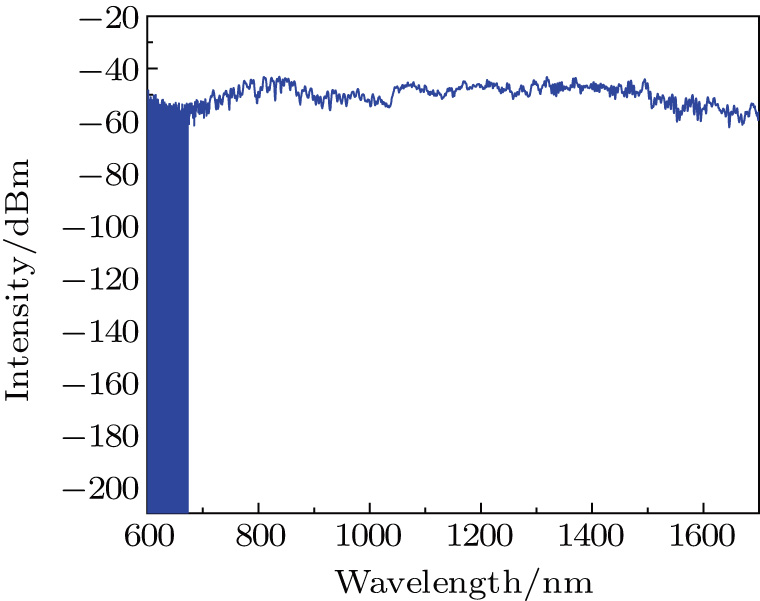 | Fig. 9. (color online) The output spectrum of the supercontinuum produced in 2 m long seven-core PCF. |
 | Fig. 10. (color online) The laser pulse trains and the pulse width of supercontinuum produced in 2 m long seven-core PCF. |
As noted above, the central wavelength of the amplifier matches well with the zero dispersion point of the seven-core PCF which can generate supercontinuum with high single pulse energy and wide spectrum pumped by the picosecond pulse amplifier with narrow pulse width and high peak power. The output supercontinuum pulse trains are stable without serious distortion and pulse splitting, which is important for the applications of the supercontinuum source. We get 20.4 W supercontinuum source with spectrum range from 680 nm to 1700 nm by using only 44.3 W of the amplifier when the length of the seven-core PCF is 2 m.
In summary, we demonstrate a supercontinuum source by adopting an all-fiber broadband picosecond pulse fiber amplifier to pump nonlinear seven-core PCF with zero dispersion wavelength covered by the spectrum of the amplifier. The nonlinear effects in normal dispersion region and negative dispersion region can help to obtain wide spectrum. An NPR mode-locked fiber oscillator of 567 ps with repetition rate of 8.47 MHz and average output power of 25.8 mW is used as a seed source to be injected into a two-stage ytterbium-doped MOPA all-fiber amplifier. The central wavelength of this amplifier is 1150 nm with the spectral width of 260 nm, and the output power is 60 W with the pulse width of 221 ps. We analyze two different lengths of seven-core PCF contrastively. When the seven-core PCF is 10 m long, the output supercontinuum ranges from 620 nm to 1700 nm with the output power of 11.7 W and pulse width of 385 ps. When only 2 m long seven-core PCF is used, the output power is enhanced to 20.4 W with a pulse width of 255 ps and a spectrum range from 680 nm to 1700 nm. The pulse trains are uniform without pulse splitting.
| [1] | |
| [2] | |
| [3] | |
| [4] | |
| [5] | |
| [6] | |
| [7] | |
| [8] | |
| [9] | |
| [10] | |
| [11] | |
| [12] | |
| [13] | |
| [14] | |
| [15] | |
| [16] | |
| [17] | |
| [18] | |
| [19] | |
| [20] | |
| [21] | |
| [22] | |
| [23] | |
| [24] | |
| [25] |


